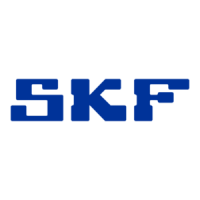3. Design and function Page 15
EN
3.2. Piston pumps for piston distributor
systems
The manually, pneumatically or hydraulically
actuated piston of the piston pump feeds the
lubricant drawn from a separate lubricant reservoir
or a reservoir mounted on the piston pump into the
piston distributor system through the pressure relief
valve and to the piston distributors.
3.2.1. Lubrication cycle sequence
The sequence of a lubrication cycle depends on the
type of piston distributors in use. Piston distributors
are differentiated into prelubrication distributors and
relubrication distributors. Prelubrication distributors
deliver the metered quantity of lubricant at the
same time that pressure is built up in the lubricant
line. Relubrication distributors supply the metered
quantity of lubricant after the pressure relief
procedure in the lubricant line.
3.2.2. Lubrication cycle of prelubrication
distributor
After the delivery piston is actuated (manually,
pneumatically or hydraulically), the lubricant is fed
through the lubricant line to the prelubrication
distributors via the pressure relief valve. The
pressure built up in the centralized lubrication
system meters the lubricant separately for each
lubrication point and feeds it to the consuming
points. After the working stroke, the actuating piston
of the piston pump is returned to its normal
position. In the process, it draws lubricant into the
suction chamber. After pressure has been relieved in
the lubricant line, the lubricant is shifted within the
prelubrication distributor from the spring chamber
into the metering chamber. The centralized
lubrication system is ready for the next lubrication
cycle.
3.2.3. Lubrication cycle of relubrication
distributor
After the delivery piston is actuated (manually,
pneumatically or hydraulically), the lubricant is fed
through the lubricant line to the relubrication
distributors via the pressure relief valve. The
pressure built up in the centralized lubrication
system feeds the lubricant into the storage chamber
of the relubrication distributors. After the working
stroke, the actuating piston of the piston pump is
returned to its normal position and pressure is
relieved in the centralized lubrication system, which
meters the lubricant within the relubrication
distributor and delivers to the lubrication point
(relubrication effect). After the lubricant has been
completely expelled to the lubrication point, the
centralized lubrication system is ready for the next
lubrication cycle.
3.2.4. Connected load
Since every working stroke of the piston pump
triggers a new lubrication procedure, be sure that
the connected load of the centralized lubrication
system is a maximum of 2/3 of the delivery volume
of the piston pump in order to ensure the necessary
reserves for pressure build-up in the centralized
lubrication system.
The connected load can be roughly calculated as
follows:
Connected load
Sum of all volumes metered by the centralized
lubrication system's distributors
+ 25% of this value (safety margin)
+ 1 cm
3
per meter of main line
(expansion loss, only for hose lines)
+ Compressibility loss per meter of main line acc. to
Table 5 (only for centralized lubrication systems
for grease supply)
Table 5. Compressibility loss in pipes
conducting grease, in cm³/m
Line
6 x 0.7
Line
8 x 0.7
Line
10 x 0.7
0.17 0.34 0.58

